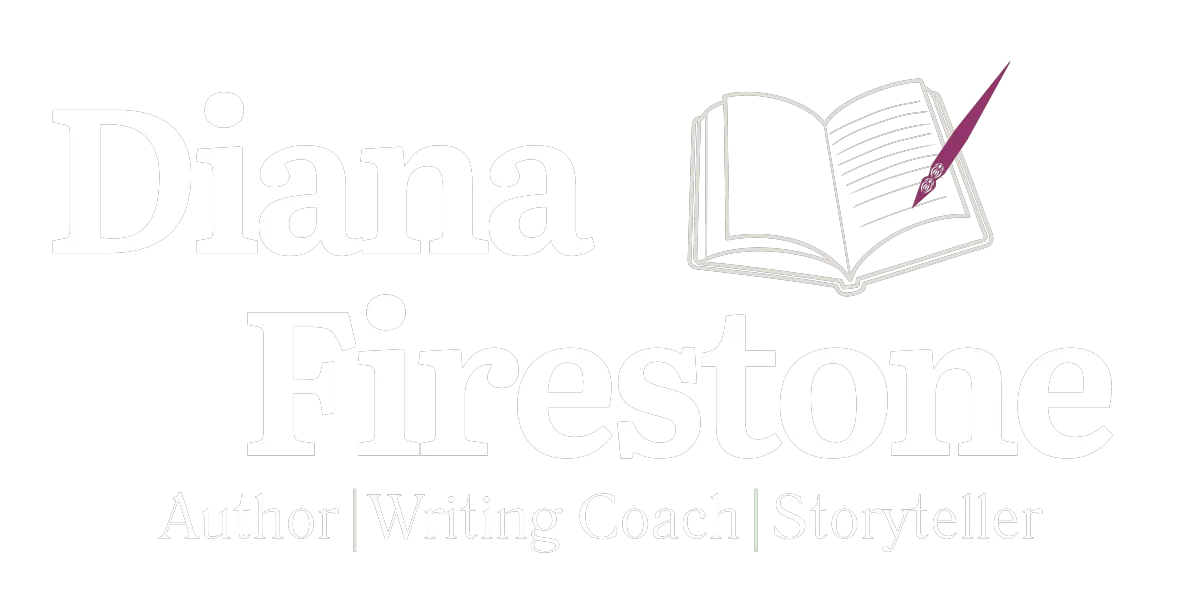Diana Tells Stories
A home for book lovers, storytellers, and anyone on a journey to find their voice. Here, you’ll find deep-dive storytelling reflections, poetry, book reviews, and writing tips
designed to inspire creativity and make writing feel less like a chore and more like an adventure.
A blog for storytellers...
Poetry, reflections, book reviews, and writing tips—because every story deserves to be told.

5 Bite-Sized Editing Rituals to Revamp Your Draft
5 Bite-Sized Editing Rituals to Revamp Your Draft
Picture this:
It’s 7 AM, your desk is scattered with crumpled pages, and you clutch a steaming double-shot espresso in one hand and a pink pen in the other. You stare down your latest draft—wondering where all those extra commas came from. You eye your latest draft, confused by all those rogue commas, and suddenly recognize how much blood, sweat, and coffee went into each line. These five quick, caffeine-powered editing rituals will help you polish your prose without drowning in red ink. Ideal for anyone, from first-time novelists to short-story savants. Let’s get started.
One-Page Espresso (or tea) Sprint
This is a timed, hyper-focused reading session of just one printed page—espresso in hand, timer set—designed to help you catch awkward phrasing or extra words before the caffeine wears off.
How to Do It:
Print Out a Single Page of your manuscript (choose a challenging section such as dialogue-heavy or action scenes).
Prepare a Quick Espresso (double shot, or your preferred strength).
Set a 10-Minute Timer.
Read the Page Aloud. Listening to your own words helps you detect clunky sentences that your eyes might gloss over.
Annotate with a Pink Pen. Make minimal notes—circle repeated words, underline run-on sentences, and put a question mark next to anything that doesn’t feel quite right.
Why It Works:
Caffeine Boost: Your neurons are firing; mistakes stand out more clearly.
Auditory Check: Hearing your sentences forces you to slow down and hear missing words or odd syntax.
Bounded Focus: Ten minutes feels short enough to avoid burnout, but long enough to make a dent in your revision.
Example:
Original Line: “She swung the sword quickly, very quickly, a bright flash of steel that lit the corridor.”
Read Aloud Discovery: “Huh, ‘quickly, very quickly’ is redundant.”
Revision: “She swung the sword—steel flashing—in the dim corridor.”
Last month, I sat at my kitchen table, espresso in hand, trying to wrangle a battle scene in my fantasy novella. By the six-minute mark, as the timer ticked down, I realized that half the “slashes” and “thrusts” were identical—my battle had become a blur of repetition. I paused, took a deliberate sip of espresso, and let the caffeine sharpen my focus. Then, with my pink pen poised, I spent the remaining minutes zeroing in on every swing and parry, swapping redundant verbs for vivid verbs and tightening each sentence’s rhythm. By the end of the sprint, the scene had energy, every blow felt distinct, and the tension leapt off the page.
Red Pen-Only in Pink
A playful twist on traditional red-ink editing: use a bright-pink pen (or any non-threatening color) to make your revisions feel less punitive and more fun.
Why It Works:
Psychology of Color: Pink feels warmer and less “final” than red. You’re more likely to embrace edits when they don’t feel like harsh red marks.
Playful Attitude: Approaching edits with a lighthearted tool helps you stay motivated—even when you’re ripping apart paragraphs.
How to Do It:
Print or Use a Tablet: Whichever you prefer. Have your pink pen or stylus ready.
Focus on One Thing: For this pass, decide: Are you looking at grammar only? Or trimming unnecessary adverbs? Or honing voice consistency?
Mark Sparingly: Circle, strike through, or jot a brief note in pink. Resist the urge to rewrite entire sections here—just flag what needs changing.
Transfer to Digital (Optional): If you’re editing digitally afterward, enter changes in your word processor.
Example:
On Page 12, Line 7: “She softly whispered, ‘I miss the ocean…so much.’”
Pink Pen Note: “Consider removing ‘softly’ (redundant with whisper).”
Revision After Transfer (Digital): “She whispered, ‘I miss the ocean. So much.’”
When I work on my short stories—or help my students polish theirs—I swap red pens for a rainbow of colors. I’ll use a bright teal to highlight a strong opening line, a sunny yellow to flag moments where the pacing drags, and a bubblegum pink to circle a phrase that sings. My students love it: when they see their pages dotted with friendly hues instead of harsh reds, they feel encouraged to experiment rather than intimidated. We even have a code: green means “This image really works,” blue means “Consider adding more detail here,” and pink means “This line makes me smile.” Suddenly, every colored mark becomes a clue, guiding us toward sharper dialogue or richer description, and editing feels like a collaborative, creative treasure hunt.
Reverse Reading
A classic proofreading technique: read each sentence backward (from the last word to the first). This trick forces your brain to focus on individual words and punctuation instead of getting lost in meaning.
Why It Works:
Isolates Typos: Since you’re not following narrative flow, missing or repeated words jump out.
Slows You Down: You can’t skim; you have to process each word.
How to Do It:
Use a Printed Page or a Digital Split Screen: Either works.
Start at the Bottom: Begin with the last sentence of the page.
Read Word by Word, Backward: For example, take:
“The old oak tree creaked in the wind.”
You’d read: “wind. the in creaked tree oak old the.”Mark Typos and Punctuation Issues: If you see “wind.” missing a period or “treeo” joined, it’s obvious.
Example:
Original Sentence: “Her eyes shimmered, gleamed in the moon light.”
Reverse Read: “light moon the in gleamed ,shimmered eyes Her.”
Catch: Extra space in “moon light” (should be “moonlight”) and an extraneous comma.
Revision: “Her eyes shimmered, gleamed in the moonlight.”
Pro Tip:
When you reverse-read, highlight or underline in a different color each time you catch a typo, so you can see if certain mistakes repeat (e.g., always missing hyphens, or mixing “it’s” vs. “its”).
Character-Voice Chessboard
This is a simple two-column chart (a “chessboard”) to compare and contrast the voices, quirks, and speech patterns of two characters side by side. This helps ensure each character stays distinct throughout your draft.
Why It Works:
Visual Contrast: Seeing both voices in parallel highlights overlap (e.g., if both characters say “like” ten times per page).
Prevents “Voice Creep”: Authors often slip into their own natural writing style, causing secondary characters to sound too much like the narrator.
How to Do It:
Pick Two Characters to Compare: Often, one protagonist and one key side character or antagonist.
Create a Two-Column Table:
Left Column: Character A’s quirks (e.g., vocabulary, speech tics, favorite catchphrases).
Right Column: Character B’s quips (e.g., slang, sarcasm, pacing).
Populate with Examples from Your Draft: As you read, jot down specific notes, such as: “Eloise uses archaic words: ‘Wherefore,’ ‘hither,’ etc.” vs. “Jaxon says, ‘Yo, chill,’ and uses sentence fragments.”
Scan for Overlap: If both columns start to look alike, it’s time to tweak one character.
Sample Table:
The Character-Voice Chessboard below (generated as a DataFrame) shows how two characters—“Eloise” and “Jaxon”—might compare.
<table> <tr> <th>Character A (Eloise) Quirks</th> <th>Character B (Jaxon) Quips</th> </tr> <tr> <td>Uses long, poetic metaphors</td> <td>Slang-heavy, casual tone</td> </tr> <tr> <td>Frequently taps pen when thinking</td> <td>Interrupts with humor</td> </tr> <tr> <td>Prefers formal, archaic vocabulary</td> <td>Short, punchy sentences</td> </tr> </table>
Step 1: Open your manuscript and pick a scene where both characters speak.
Step 2: On a fresh sheet (or digital doc), create two columns labeled with character names.
Step 3: As you read dialogue and internal thoughts, jot down any distinguishing features (e.g., “ramble-y speeches” vs. “one-liners”).
Step 4: If you notice that Eloise and Jaxon both start saying “ain’t” in the same scene, revise Jaxon to have a different verbal tic (e.g., replace “ain’t” with “nah, I’m good”).
Step 5: Repeat this exercise for other character pairings (e.g., protagonist vs. sidekick) until each voice feels unmistakably unique.
When I first drafted my 2,500-word short story for a competition, both of my protagonists kept saying “seriously?” in nearly every bit of dialogue. It wasn’t until I laid out a mini chessboard to compare their voices that I realized—they were practically interchangeable. I revised one character to speak more lyrically (“Truly? You intend to challenge me so?”), while the other got a snappier edge (“For real? You’re actually doing that?”), giving each their own distinct flavor despite the tight 2,000–3,000-word count.
Feedback Loop
A quick peer-review swap focusing on bite-size chunks (100–150 words) instead of marathon feedback sessions. This keeps critiques light, targeted, and less intimidating.
Why It Works:
Fast Feedback: Writers receive focused suggestions without waiting weeks for a full critique.
Scalable: You can run this exercise with a writing partner, a small workshop, or even a Discord group from your highest Patreon tier.
Builds Community: Sharing in small doses encourages more interaction and less “feedback fatigue.”
How to Do It:
Select a 100–150 Word Passage that you’d like feedback on (could be a key scene or tricky transition).
Exchange with a Partner:
You send your passage to a fellow writer, and they send theirs to you.
Focus only on one aspect—dialogue authenticity, world-building clarity, or emotional resonance.
Provide Targeted Notes:
For example, “Your fight scene is exciting, but I’m confused who’s speaking between lines 3–5.”
Or, “I love the imagery here, but the last sentence feels rushed—maybe slow it down.”
Incorporate Feedback Quickly:
You’ll get a few bullet points; implement or discuss each bullet.
This isn’t a full edit—just a “quick polish.”
Example:
Original Passage (Submitted):
“Aria burst into the tavern, blades swinging overhead. The crowd scattered like frightened sparrows. She couldn’t believe he was here—in the heart of enemy territory—laughing as though nothing mattered.”
Partner’s Feedback (Focus: Tension & Clarity):
“Blades swinging overhead” is vivid, but are they hers or the guards’? Maybe specify.
The phrase “crowd scattered like frightened sparrows” is strong, but could be trimmed to maintain pacing.
“He” in “she couldn’t believe he was here” needs context—mention his name or relation.
Revision After Feedback:
“Aria burst into the tavern, her twin daggers flashing over her head as guards dove aside. The patrons scattered like frightened sparrows. She couldn’t believe Roran was here—in the heart of enemy territory—laughing as though nothing mattered.”
Tip 1: Label each chunk with the feedback focus (e.g., “Character Motivation,” “Setting Description,” “Emotional Impact”).
Tip 2: If you’re in a larger group, rotate pairs so you get fresh perspectives.
Tip 3: Always send a short “thank-you” note highlighting one thing that resonated—this fosters goodwill and encourages future swaps.
Wrapping Up & Next Steps
By integrating these five bite-sized rituals into your editing routine, you’ll find that even a fifteen-minute session can yield noticeable improvements. Whether you’re grabbing that espresso for an early-morning sprint or swapping snippets with a fellow writer on Discord, keep the process playful and focused. Editing shouldn’t feel like a chore—it’s an essential and creative part of bringing your story to life.
Let’s Recap:
One-Page Espresso Sprint: Read one page aloud in ten minutes.
Red Pen—Only in Pink: Use a non-threatening color to make edits feel fun.
Reverse Reading: Slow down and catch typos by reading backward.
Character-Voice Chessboard: Ensure each voice stays distinct with a side-by-side chart.
Fun-Sized Feedback Loop: Exchange 100–150 word passages for quick, targeted feedback.
Bonus: Share Your Own “Espresso & Ink” Moments
Comment Below: Which ritual are you most excited to try?
Tag Me on Instagram: Use #EspressoAndInkEdits to share a photo of your annotated page or chessboard table.
Join My Discord (Tier 3 Patrons): Swap micro-chunks with fellow writers and keep the editing fun rolling.
Pour that pink pen back into your espresso cup (metaphorically speaking), and let every sip fuel your next edit. Your draft is closer to polished gold than you think with just a few rituals away.
Happy editing!
🖤 Diana
📌 Follow my journey & get exclusive writing resources:
🔗 Join my newsletter
📚 Explore my resources
📖 Follow me on Instagram
Every story starts with a single word. Make yours unforgettable.
Ink Between the Lines
Get your monthly fix of flash fiction, spicy writing tips, and prompts that’ll actually get you writing (instead of scrolling through TikTok for hours). Expect exclusive stories, all the inspiration you need, and just enough sass to make you question your life choices—and your character's, too. Oh, and yes, there will be terrible puns.
Sign Up and Let’s Get Writing!
(Warning: Coffee addiction may be encouraged, but not required!)
All Rights Reserved 2025 - www.dianafirestone.com - Terms & Conditions


